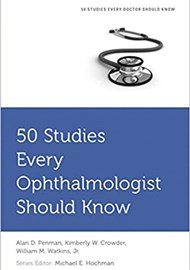This book features a compilation of 50 important clinical studies that have left a profound impact on the current clinical practice of ophthalmology. From the 1980 botulinum toxin injection study by AB Scott to the United Kingdom Glaucoma Treatment Study published in 2015 by Garway-Heath et al., the authors have reviewed the landmark studies published over the past four decades before selecting the top 50 studies that they deemed to have contributed the most to the development of current practice.
The studies cover a wide range of topics across different anatomical sections, ranging from treatment of corneal diseases to investigation modalities of optic nerve pathologies. Most of the selected studies are randomised controlled trials, but a few relevant observational studies have also been included.
Besides detailing the framework of each study, the authors critically analyse the study design and provide commentary on other relevant studies of similar topics. For instance, they do not only provide a detailed clinical overview of each study, but also write about the limitations and potential biases. A succinct summary of the main findings and implications of the study is provided at the end of each chapter. In order to help consolidate the knowledge, the authors also design a clinical case / quiz (with answers provided) for each study that has been selected.
Despite the huge selection of studies included, I find the book easy to navigate because the studies are grouped based on anatomical sections and arranged according to alphabetical order (cornea, cataract, glaucoma, vitreoretinal, macula, uveal tract, and orbit / eyelids / extraocular muscles / optic nerve). The layout used (research question, inclusion criteria, exclusion criteria, study overview, interventions, end points, results, limitations and summary) makes the study easy to follow despite the sheer amount of information included in each study. I also appreciate how the authors try to cater to the readers who wish to read more about the subject by including a list of relevant studies at the end of each chapter. The quiz that comes with each study is also immensely useful in helping to reinforce the take home messages.
Ophthalmology trainees who are about to start training in a new subspecialty or are preparing for board review might find this book a useful read. Besides, trainees who are preparing for a journal club presentation might also find the book a good investment if they are struggling to find a suitable study to review. In addition to ophthalmologists in training, this book will also stand medical students in good stead as it could serve as a good starting point on learning how to critically analyse a scientific study.
Ophthalmology is a constantly evolving field and what might be perceived as state-of-the-art technologies just a few years back might now be regarded as obsolete practices. This book provides an avenue for us to pause and have a look back at how past clinical studies have tremendously affected the current practices today. I would recommend this book to those have who wish to have a better understanding of how current guidance takes its form today or those who are simply intrigued by the evolvement of ophthalmology practice.




